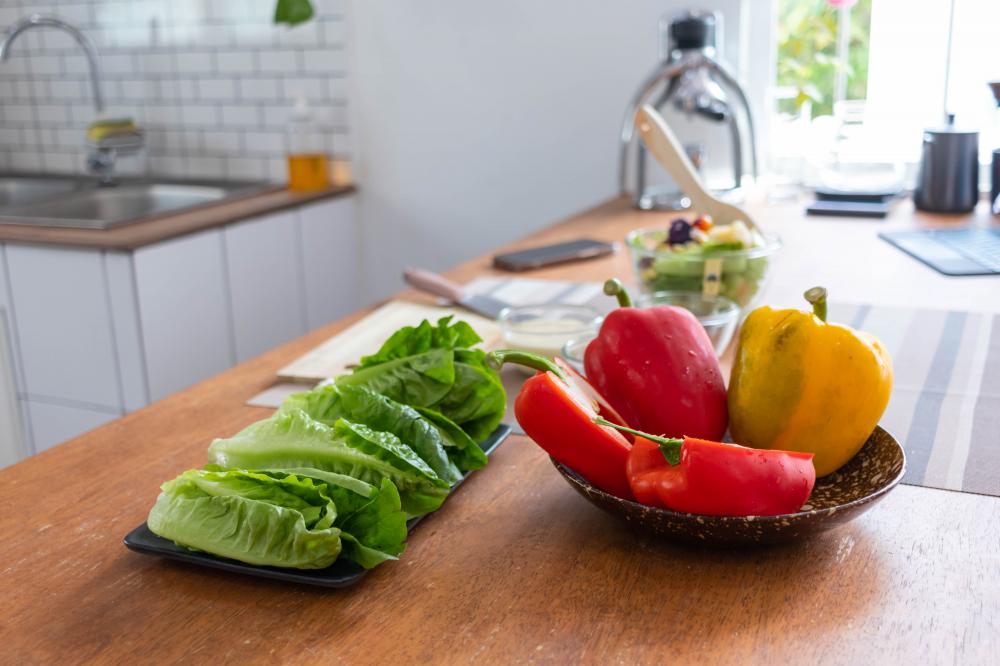
Transformative Kitchen Products
When considering Reducing Plastic Waste at Home, the kitchen emerges as a crucial starting point. Prepare to revolutionize your kitchen practices, focusing on sustainable habits that minimize environmental impact. This transformation can significantly reduce your plastic footprint.
Innovative Storage Solutions
Transitioning to glass or stainless-steel containers for storing leftovers not only enhances food safety but also curtails plastic usage. By embracing these alternatives, households can diminish the reliance on plastic wraps and single-use containers, contributing to Reducing Plastic Waste at Home.
Mindful Purchasing Habits
Bulk purchasing and utilizing refills are effective strategies to cut down on packaging waste. Supporting markets that offer bulk sections allows consumers to bring their own containers, fostering a more sustainable shopping experience.
Eco-friendly Cleaning Practices
Adopt reusable cleaning products, such as washable cloths or biodegradable sponges, to further reduce plastic waste. This shift not only aids in Reducing Plastic Waste at Home but also introduces a natural freshness to domestic spaces.
Bathroom Sustainability Insights
Bathrooms, often brimming with single-use plastics, are ripe for transformation. Cultivating eco-friendly habits in this space is pivotal for Reducing Plastic Waste at Home. Consider these strategies to make impactful changes.
Sustainable Swaps
Switching to bamboo toothbrushes and refillable soap dispensers are small steps with significant effects. These alternatives not only decrease environmental impact but also promote a healthier lifestyle by avoiding harmful plastics.
Choosing shampoo bars over plastic-bottled options is another commendable effort. This transition highlights a commitment to sustainability, contributing substantially to household goals of Reducing Plastic Waste at Home.
Encouraging Reusability
Investing in long-lasting products, like safety razors, defies the single-use culture prevalent in bathrooms. These items, while initially more expensive, prove economical over time and support reducing plastic dependency.
Wardrobe and Beyond
Reducing Plastic Waste at Home extends beyond kitchens and bathrooms. Wardrobes and household practices also play a vital role in sustainability.
Conscious Clothing Choices
Opt for natural materials like organic cotton or hemp, minimizing environmental impact during production and disposal. Embracing quality over quantity encourages a sustainable fashion approach, aligning wardrobe choices with ecological values.
Consider donating or upcycling garments to prolong their lifecycle, reducing the need for new purchases and ultimately contributing to Reducing Plastic Waste at Home. This practice promotes a circular economy mindset.
On-the-go with Intention
For individuals committed to Reducing Plastic Waste at Home, incorporating sustainable practices into daily activities is crucial. Learn to carry sustainability beyond the household.
Reusable Carry Items
Integrating items like reusable water bottles and tote bags into daily routines significantly lessens single-use plastic reliance. These changes demonstrate a commitment to broader sustainability efforts, influencing personal habits and community impact.
Mindful Meal Planning
Preparing meals in advance using reusable containers minimizes the need for disposable packaging. This practice saves money, supports healthier lifestyles, and aligns with Reducing Plastic Waste at Home.
Engage with local businesses that emphasize sustainable packaging when dining out. Supporting these establishments encourages more eco-friendly practices across the board, amplifying the collective effort in reducing plastic waste.

Sustainable Living Starts at Home
Implementing eco-friendly practices for sustainable living often begins with household habits. Simple changes, like conserving water by taking shorter showers or collecting rainwater for gardening, can profoundly impact both the environment and personal utility costs. Another crucial step is optimizing energy use; turning off lights when leaving a room or investing in energy-efficient appliances can significantly reduce carbon emissions. As residential consumption accounts for a substantial percentage of emissions, these actions collectively contribute to a positive ecological footprint.
Exploring sustainable alternatives for daily products is another valuable practice. Opting for biodegradable cleaning supplies and reusable cloths instead of disposable paper towels not only reduces waste but also aligns with eco-friendly practices for sustainable living. With many brands releasing eco-conscious product lines, finding sustainable options has become easier and can make everyday tasks more environmentally friendly.
Conscious Consumption and Community Impact
Personal consumption habits extend beyond the home and deeply intertwine with community well-being. Engaging in local community-supported agriculture (CSA) programs enables individuals to support sustainable farming practices while reducing the carbon footprint associated with transporting goods across long distances. This connection between eco-friendly practices for sustainable living and community health embodies a broader vision where individual choices have ripple effects.
Travel and transportation choices also play a vital role in sustainable living. Carpooling, biking, or using public transportation can drastically reduce individual carbon emissions. For those who drive, maintaining vehicles to ensure optimal fuel efficiency is an important consideration that can reduce environmental impact. Encouraging community initiatives, like shared transportation services, further amplifies the collective benefits of eco-friendly practices.
Origen promotes active community engagement through their network, inspiring individuals to embrace roles as environmental stewards. Workshops on sustainable living provide practical knowledge on how small actions can accumulate, driving significant change. Being part of such communities can elevate awareness and commitment to nurturing an environment where eco-friendly practices flourish.
The integration of eco-friendly practices for sustainable living is also about creating systems that support these ideals. Community gardens, for example, bring people together, fostering a shared responsibility toward sustainable food production. These spaces encourage learning and collaboration, transforming individual efforts into community achievements.
Creative Solutions for a Greener Future
Innovative solutions offer fresh perspectives on eco-friendly practices for sustainable living. For instance, integrating technology with sustainability goals can yield exciting outcomes: smart home devices that monitor and optimize energy use, or apps that help track and manage individual carbon footprints. These tools not only enhance convenience but also provide valuable data to understand environmental impact.
In the realm of fashion, upcycling clothing and choosing sustainable brands reflect a growing awareness of eco-friendly practices. By reimagining clothing purchases and prioritizing quality over quantity, individuals contribute to reducing the fast-fashion cycle that heavily burdens our planet.
Engaging with digital communities through platforms like Origen’s Facebook and Quora groups can inspire additional eco-friendly practices for sustainable living. Sharing experiences and strategies within these networks fosters a sense of unity, while also offering fresh approaches from diverse perspectives.
Finally, aligning with businesses dedicated to sustainability amplifies the individual impact. Supporting companies with transparent sustainability practices endorses a market shift towards environmentally responsible operations. This change not only influences corporate behavior but also inspires other consumers to adopt eco-friendly practices.
Essentials of Organic Gardening
Healthy Soil Foundation
Soil is the backbone of any successful organic garden, and understanding its intricacies can lead to flourishing plants. A well-balanced soil includes a mix of sand, silt, and clay, enriched with organic matter to improve texture and fertility. The goal is to achieve a loamy soil structure, which allows air, water, and roots to penetrate easily.
For optimal soil health, regular addition of compost is crucial. Compost not only enriches soil nutrients but also enhances its capacity to retain moisture. The natural decomposition process in composting can be likened to a bustling city of microorganisms working tirelessly to break down organic waste, turning it into black gold for your garden. Explore our website for organic gardening tips.
Integrated Pest Management
Pests present a perennial challenge in gardening, yet organic methods offer innovative and eco-friendly control strategies. Integrated Pest Management (IPM) advocates for a combination of techniques to manage pest populations while minimizing environmental impact. IPM emphasizes biological control methods, such as introducing beneficial insects like ladybugs to feed on aphids.
Crop rotation is another effective tool in the organic gardener’s arsenal. By changing the planting location of specific crops each season, gardeners can disrupt the lifecycle of pests, preventing them from establishing a stronghold in any one area. This method not only reduces pest problems but also promotes soil health and biodiversity.
Cultivating Biodiversity
Companion Planting
Organic gardening thrives on the principle of synergy within the garden ecosystem. Companion planting leverages natural plant relationships to enhance growth and deter pests. For instance, planting basil near tomatoes can improve flavor and deter harmful insects, creating a win-win situation for both crops.
Beyond pest control, some plants release beneficial chemicals into the soil, promoting growth for their neighbors. This network of positive interactions mirrors Origen’s philosophy of interconnectedness and community support, where each part plays a vital role in the whole.
Soil Microbial Diversity
Organic gardening also emphasizes the unseen, yet powerful, microbial life thriving in healthy soil. A diverse microbial population is essential for breaking down organic matter, cycling nutrients, and suppressing soil-borne diseases. Encouraging microbial diversity involves minimizing soil disturbance and avoiding synthetic fertilizers.
Cover crops such as clover or vetch can be grown and tilled into the soil, adding both nutrients and organic carbon. These practices not only enhance soil microbial life but also reduce erosion, exemplifying how nurturing unseen elements can lead to profound benefits.
Sustainable Practices for Eco-Friendly Gardens
Water Conservation Techniques
Ensuring water sustainability is a key concern for organic gardeners, as efficient water use reduces environmental impact and conserves a vital resource. Mulching with organic materials like straw or wood chips helps retain soil moisture, reducing the need for frequent watering.
Rain barrels are a practical solution to harvesting rainwater, providing an eco-friendly water source for gardens. This practice not only conserves water but also empowers gardeners to reduce their dependence on municipal water supplies, echoing the ethos of self-sufficiency championed by Origen.
Minimizing Waste
Waste reduction is another cornerstone of sustainable organic gardening. Composting kitchen scraps and garden waste closes the nutrient loop, turning would-be waste into valuable compost. Embracing a zero-waste mindset involves creatively repurposing materials, like using old containers as planters or employing cardboard as a weed suppressant.
- Utilize greywater from household tasks for irrigation.
- Create a worm bin for efficient composting of kitchen scraps.
- Use organic materials to build a natural fence or trellis.
These practices not only reduce waste but also foster a deeper connection to the garden, aligning with the broader mission of Origen to cultivate personal and environmental harmony.

How to reduce plastic waste in household?
Reducing plastic waste in the household begins with awareness and small changes that can make a big difference. Start by analyzing your daily habits and identifying where plastic is most used in your home. For instance, replacing plastic grocery bags with reusable cloth totes can significantly decrease the single-use plastics you accumulate.
Consider the kitchen as a primary area for transformation. Opt for glass or stainless-steel containers to store leftovers, reducing your reliance on plastic wraps. Bulk buying and using your own containers at stores that allow it can also cut down on unnecessary packaging. In the bathroom, switch to bamboo toothbrushes and shampoo bars to minimize single-use plastics.
Integrating these practices not only contributes to a reduction in plastic waste but also aligns with a lifestyle that feels more connected to the broader mission of sustainability. How have you managed to cut down on plastic in your life, and what challenges have you faced in this journey?
How do I get rid of plastic in my home?
Reducing plastics in your home involves a layered approach of swapping out single-use products for sustainable alternatives, recycling effectively, and educating family members about the importance of reducing plastic dependency. For instance, instead of using disposable cutlery and plates, invest in a set of reusable ones.
Awareness is key. Begin by conducting a household audit to identify the plastic items you can replace. For example, you might find that your cleaning supplies are predominantly plastic-based. By switching to recycled or biodegradable packaging options and using homemade cleaning solutions, you can diminish your household’s plastic footprint.
Moreover, joints efforts to build a community around these practices can amplify your impact. Sharing your experiences and creative solutions with neighbors or local groups can inspire collective action towards minimalism and sustainability. What single action have you found most effective in reducing plastic in your home?
How can I reduce my plastic bottles at home?
Reducing plastic bottles at home often starts with replacing bottled water with a good filtration system. Not only does this combat the waste generated by disposable bottles, but it also promotes healthier drinking habits. You might also consider investing in a soda-making machine to cut down on carbonated drink bottles.
For other plastic containers, look into bulk purchasing options that allow you to refill reusable bottles with products like shampoo, conditioner, and cleaning supplies. This can dramatically decrease the number of plastic bottles you need to recycle or dispose of.
Adopting these changes is an excellent way to lead by example, showing those around you how possible it is to live more sustainably. Have you tried bulk purchasing or other zero-waste shopping methods? What has been your experience?
How to dispose of plastic at home?
Proper disposal of plastic is a crucial component of reducing household waste. First, make sure to separate your plastics according to local recycling guidelines. Many municipalities offer detailed instructions on how to recycle plastic properly. Participating in these programs ensures that plastics are processed correctly and efficiently.
For plastics that can’t be recycled at the curb, consider specialized recycling programs that accept items such as plastic bags or styrofoam, which are often not accepted in regular bins. These may be found at local grocery stores or community centers.
Beyond disposal, it’s vital to focus on reducing the input of plastic into your home. Adopting a zero-waste lifestyle and utilizing sustainable alternatives can mitigate the need for disposal altogether. Have you discovered any creative ways to upcycle or repurpose plastic materials before disposal?
How can I practice eco-friendly living effectively?
Practicing eco-friendly living effectively resonates with Origen’s holistic approach towards personal growth and community engagement. Start small by integrating sustainable habits into your daily routine, such as reducing water usage with shorter showers or turning off lights when not in use. These actions contribute to a more sustainable lifestyle and reduce your ecological footprint.
Conscious consumption plays a significant role as well. Supporting local farms and choosing organic products align with eco-friendly principles, emphasizing quality and environmental responsibility. Investing in energy-efficient appliances also makes a substantial impact.
Eco-friendly living is a journey of self-discovery and improvement, where each small step contributes to a more significant change. What small sacrifice are you willing to make today for a long-term sustainable future?
Resources
- Environmental Protection Agency – The EPA’s official website provides valuable information on environmental protection and sustainability.
- Organic Consumers Association – A nonprofit organization focused on promoting organic farming and sustainable agriculture.
- Center for Biological Diversity – An organization dedicated to protecting and preserving biodiversity through advocacy and conservation efforts.
- Sustainable Table – A resource for sustainable food practices, including organic gardening and responsible consumption.
- Natural Resources Defense Council – An organization dedicated to protecting the environment and promoting sustainable practices.